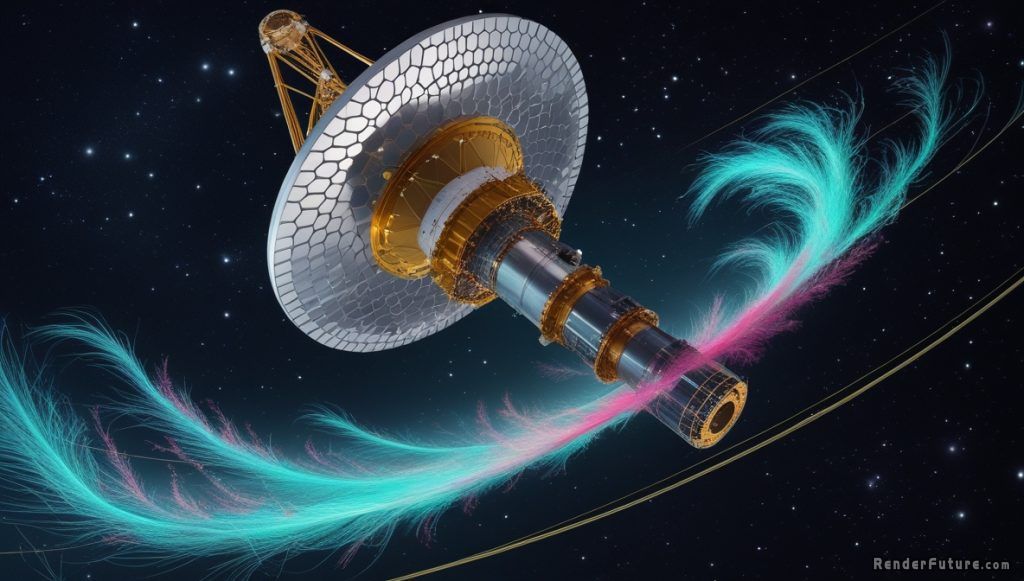Scientists Find Strongest Evidence Yet of Life on an Alien Planet
 For centuries, humanity has gazed at the stars, wondering: Are we alone? Today, we may be closer than ever to answering that question. In a groundbreaking discovery, astronomers using the James Webb Space Telescope (JWST) have detected chemical signatures in the atmosphere of an exoplanet—K2-18 b—that, on Earth, are only produced by living organisms. The implications are profound—if verified, this could represent the first tangible evidence that life exists beyond our solar system.
For centuries, humanity has gazed at the stars, wondering: Are we alone? Today, we may be closer than ever to answering that question. In a groundbreaking discovery, astronomers using the James Webb Space Telescope (JWST) have detected chemical signatures in the atmosphere of an exoplanet—K2-18 b—that, on Earth, are only produced by living organisms. The implications are profound—if verified, this could represent the first tangible evidence that life exists beyond our solar system.
This isn’t just another exoplanet detection. This could be the first real hint of alien life, a discovery that would fundamentally reshape our understanding of biology, chemistry, and our place in the cosmos. The findings have sent shockwaves through the scientific community, with researchers cautiously optimistic that we may be on the brink of one of humanity’s greatest revelations.
A World Unlike Any Other
Located 124 light-years away in the constellation Leo, K2-18 b is no ordinary planet. It’s a “Hycean world”—a theorized class of exoplanets with vast liquid water oceans beneath a hydrogen-rich atmosphere. What makes this discovery extraordinary is the presence of dimethyl sulfide (DMS) and dimethyl disulfide (DMDS)—gases that, on Earth, are exclusively produced by marine microbes like phytoplankton. The detection of these molecules in such high quantities suggests that K2-18 b could be teeming with microbial life, hidden beneath its thick, steamy atmosphere.
- Mass: 8.6 times that of Earth
- Diameter: 2.6 times larger than Earth
- Orbit: Lies in the habitable zone of its star, where liquid water can exist
 The implications are staggering. If confirmed, this could mean K2-18 b isn’t just a water world—it might be a living world, a distant cousin of Earth where biology has taken hold in an alien ocean. The planet’s sheer size and composition make it unlike anything in our solar system, forcing scientists to reconsider what conditions might truly support life.
The implications are staggering. If confirmed, this could mean K2-18 b isn’t just a water world—it might be a living world, a distant cousin of Earth where biology has taken hold in an alien ocean. The planet’s sheer size and composition make it unlike anything in our solar system, forcing scientists to reconsider what conditions might truly support life.
The Smoking Gun: Biosignatures in the Atmosphere
The JWST didn’t just stumble upon these gases. Scientists used the transit method, analyzing starlight filtering through K2-18 b’s atmosphere as it passed in front of its host star. The data revealed a chemical fingerprint unlike anything seen before on an exoplanet—one that, if found on Earth, would be an undeniable sign of biological activity. The precision of JWST’s instruments allowed researchers to detect these molecules with 99.7% confidence, meaning there’s only a 0.3% chance this is a statistical anomaly.
 “This is a transformational moment,” says Dr. Nikku Madhusudhan, lead researcher from the University of Cambridge. “We’re entering the era of observational astrobiology, where we can finally test hypotheses about life on other worlds with real data.” The team also found that the concentrations of DMS and DMDS were thousands of times higher than what exists in Earth’s atmosphere—a disparity so vast that non-biological explanations struggle to account for it.
“This is a transformational moment,” says Dr. Nikku Madhusudhan, lead researcher from the University of Cambridge. “We’re entering the era of observational astrobiology, where we can finally test hypotheses about life on other worlds with real data.” The team also found that the concentrations of DMS and DMDS were thousands of times higher than what exists in Earth’s atmosphere—a disparity so vast that non-biological explanations struggle to account for it.
But before we declare “Aliens found!”, scientists urge caution. The history of astronomy is littered with false alarms, from the “canals” of Mars to the infamous “Wow! signal.” While the evidence is compelling, extraordinary claims require extraordinary proof—and that means ruling out every possible non-biological explanation.
Could There Be Another Explanation?
While the evidence is compelling, science demands skepticism. Some key questions remain: Could these gases form through some exotic, unknown chemistry that doesn’t involve life? Could the readings be misinterpreted due to instrumental noise or unexpected atmospheric interactions? Researchers are already brainstorming alternative scenarios, such as volcanic outgassing or photochemical reactions, but so far, none fully explain the data.
“We must be thorough,” warns Dr. Christopher Glein of the Southwest Research Institute. “The data is tantalizing, but we need independent verification from other telescopes and more detailed atmospheric modeling.” The next step is to observe K2-18 b again with JWST, this time using different instruments to cross-check the findings. If the signal persists, confidence will grow—but if it vanishes, scientists will have to go back to the drawing board.
One thing is certain: this discovery has ignited a new wave of excitement in the search for extraterrestrial life. Whether or not K2-18 b harbors biology, the fact that we can now detect such subtle signatures in distant atmospheres is a testament to how far astronomy has come.
What’s Next in the Hunt for Alien Life?
The JWST will now conduct follow-up observations to confirm the findings. If the signals hold, K2-18 b could become the first confirmed inhabited exoplanet, a milestone that would rival the Copernican revolution in its significance. But even if this particular lead doesn’t pan out, the techniques developed for this study will pave the way for future discoveries.
But the search doesn’t stop there. Future missions, like the Habitable Worlds Observatory (HWO), could provide even sharper insights. Imagine:
- Direct imaging of exoplanets—seeing oceans, continents, maybe even bioluminescent algae blooms.
- Detecting industrial pollutants—signs of intelligent alien civilizations.
It sounds like science fiction, but with JWST’s discoveries, we might be on the verge of turning speculation into reality. The next decade could see us not just finding life, but characterizing it—determining whether it’s microbial, complex, or even technological.
A New Era of Discovery
For now, K2-18 b remains a mystery—one that could redefine our place in the universe. Whether this discovery confirms life or not, one thing is certain: We are closer than ever to finding out if we’re alone. The mere possibility that we’ve detected a biological signature on another world is a humbling reminder of how vast and strange the cosmos truly is.
And if life does exist out there? The implications are beyond imagination. It would mean that life is not a fluke—that the universe is brimming with potential, waiting to be explored. For now, we watch, we wait, and we wonder: What else is out there?

References and Sources
- The Astrophysical Journal Letters – Peer-reviewed study detailing JWST’s findings on K2-18 b’s atmospheric biosignatures. https://iopscience.iop.org/journal/2041-8205
- NASA’s James Webb Space Telescope Official Site – Updates on exoplanet research and future observational targets. https://www.nasa.gov/mission_pages/webb/main/index.html
- University of Cambridge Institute of Astronomy – Research team’s official statements on Hycean worlds and biosignatures. https://www.ast.cam.ac.uk










